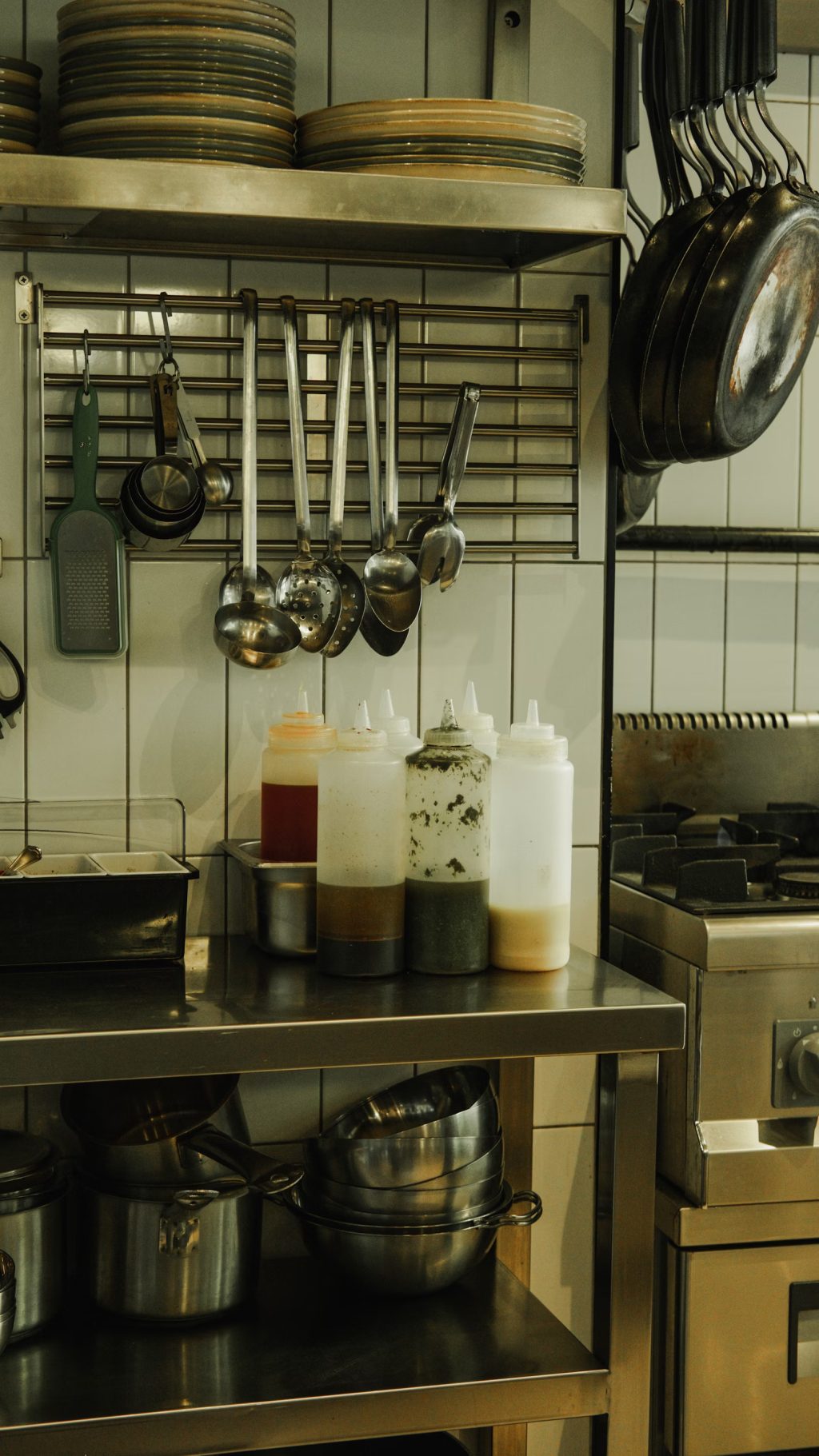

Understanding Various Stainless Steel Finishes
Before cleaning stainless steel kitchen appliances, it’s essential to understand their properties. These appliances are known for their scratch-free and rust-resistant qualities, but proper cleaning techniques are crucial to maintain their appearance. Just as responsible parenting requires knowledge and care, so does the upkeep of stainless steel. These appliances typically feature three main finishes, each serving different purposes. Here’s a closer look at them.
Brushed Finish
You can quickly tell if your device has a brushed finish by looking for surface lines that run consistently in one direction. This distinct texture is easy to identify, and in some instances, it is referred to as a satin brush due to its soft, understated sheen. The brushed finish is trendy in household appliances because it resists fingerprints and scratches, making it practical and visually appealing. This characteristic makes it a top choice for kitchen appliances, where daily use can leave noticeable marks on other finishes. The subtle, linear design of a brushed finish gives it a clean, modern appearance that fits seamlessly with contemporary interior styles.
If you look closely at the surface of your appliance and notice that the lines are uniform, you can be sure it features this durable and stylish finish. This design feature adds aesthetic value and reduces the amount of visible wear and tear, making it a functional choice for high-traffic areas like kitchens.
Polished Finish
On the other hand, a polished finish presents a much shinier and more reflective surface than the brushed option. You can easily recognize it by the way it mimics a mirror, allowing you to see your reflection on the steel’s surface. This high-gloss appearance is often used for high-end equipment because it instantly elevates the visual appeal of any appliance, giving it a sleek, luxurious look. However, while its glossy surface is stunning, it is also more prone to showing fingerprints and scratches.
Extra care is needed to keep polished surfaces looking pristine, mainly if used in frequently touched items like dishwashers or other luxury home appliances. As a result, regular cleaning and maintenance are essential to preserve its glossy finish. Despite the upkeep, many homeowners choose this finish for its ability to catch the light and enhance the overall elegance of a room. The polished finish adds sophistication, making appliances stand out, particularly in modern or upscale interiors.
Matte Finish
The matte finish is the opposite of a polished surface, offering a non-reflective, low-gloss appearance. Its coarse texture gives it a distinct, rugged, functional, and aesthetically pleasing look. Like the brushed finish, the matte surface is highly resistant to fingerprints and scratches, making it a popular choice for busy households or industrial settings. The rough texture helps conceal minor defects, making it easier to maintain over time without worrying about minor imperfections becoming visible. This quality makes it ideal for environments with bright lighting since you won’t have to deal with distracting reflections while you work.
Furthermore, people often choose the matte finish for its durability, as it holds up well against daily wear and tear, making it ideal for items that need to withstand heavy use. The durability and practicality of this finish make it a preferred option for both commercial and residential applications, where both style and resilience are needed.
Must-Have Kitchen Cleaning Tools and Their Uses
After learning about different appliance finishes, you must use the proper cleaning tools to maintain their appearance. With the appropriate cleaning supplies, you risk damaging your appliances, making them easier to clean or maintain over time. Knowing which tools to use ensures you clean your appliances effectively without scratching or discoloring their surfaces. By using the right products, you can extend the lifespan of your kitchen items and keep them looking spotless. Typically, every kitchen should have seven essential cleaning tools for maintaining appliances.
Microfiber Towel
A microfiber towel is necessary for cleaning stainless steel kitchen appliances because its soft, non-abrasive fibers gently remove dirt and smudges without damaging the surface. Unlike regular towels, microfiber absorbs significantly more water—up to 95% more than cotton towels—making it highly efficient for drying surfaces without leaving streaks. This quality makes it an ideal tool for keeping appliances like stainless steel refrigerators and ovens scratch-free. Microfiber is also effective in trapping dust and particles, making it an excellent all-around cleaning tool for daily use. Choosing a microfiber towel ensures your appliances stay clean while preserving their smooth, shiny finish.
Mild Dish Soap
Mild dish soap is a gentle yet effective cleaning solution for tougher stains or greasy buildup on your appliances. Mixing mild soap with warm water creates a cleaning agent that can dissolve grime without harming the appliance’s surface. Manufacturers specially design mild dish soaps like Joy, Dawn, or Ivory to be gentle and free of harsh chemicals. These products provide a safer alternative to stronger cleaners such as bleach or ammonia. Soak a microfiber towel in the soapy water and wipe away dirt and grease. Using mild dish soap ensures that your appliances stay in top condition without the risk of damaging their finish.
Distilled White Vinegar
Distilled white vinegar is an excellent choice for a more powerful cleaning agent. Its acidic properties make it effective at breaking down stubborn stains and maintaining the shine of stainless steel surfaces. Unlike other types of vinegar that contain coloring agents, distilled white vinegar is clear, preventing any risk of discoloring your appliances. To use, dilute it with water and spray it onto the appliance surface, or apply it directly to tough stains. Vinegar is also great for sanitizing while preserving the natural beauty of stainless steel, making it a go-to option for deeper cleans.
Stainless Steel Cleaner
If you prefer a more targeted solution, choose stainless steel cleaners specifically formulated to clean and polish stainless steel appliances. These cleaners conveniently enhance your appliances’ shine while removing stains and fingerprints. By choosing a stainless steel cleaner, you can avoid the trial and error of homemade solutions and achieve a professional-grade clean. Research and select a product that aligns with your budget and specific needs to ensure you get the best results for your kitchen.
Soft-bristled Brush (Old Toothbrush)
A soft-bristled brush or an old toothbrush is perfect for cleaning hard-to-reach appliance areas. This tool is handy for getting into the nooks and crannies of kitchen items like ovens or around the handles of refrigerators. The soft bristles ensure that your appliances are cleaned thoroughly without scratching their surfaces. Using an old toothbrush is a budget-friendly way to keep your appliances clean, as it collects fine dust and dirt in areas a cloth may not reach. This simple yet effective tool helps maintain your appliances’ shine and cleanliness.
Rubber Gloves
Rubber gloves protect your hands while cleaning stainless steel kitchen appliances. Whether using mild dish soap, vinegar, or a stainless steel cleaner, gloves provide a necessary barrier against potentially irritating substances. Wearing gloves, especially when handling more potent cleaning agents, is crucial as they safeguard your skin while ensuring your appliances receive the thorough cleaning they require. Choosing suitable gloves helps maintain your health and provide the pristine condition of your kitchen equipment.
Tips For Cleaning Stainless Steel Kitchen Appliances
Maintaining the sleek appearance of stainless steel kitchen appliances requires regular care and effective cleaning techniques. Understanding how to use various cleaning tools and incorporating them into your routine can make a significant difference. By following these practical tips for cleaning stainless steel kitchen appliances, you can keep them looking pristine with minimal effort.
Clean Regularly
Once you’ve familiarized yourself with the various cleaning tools and their uses, make it a point to clean your stainless steel appliances regularly. Regular maintenance helps prevent grime buildup and keeps your appliances looking their best. Aim to wipe down the surfaces after each use to maintain a clean and polished appearance. Consistency is vital—incorporate this into your routine to ensure your appliances remain in top condition without requiring intense, deep cleaning sessions.
Develop a Habit
Transform cleaning your appliances into a regular habit. Set a specific time or routine for this task so it becomes an effortless part of your daily or weekly schedule. Making it a habit ensures that your appliances stay spotless and extend their lifespan. This proactive approach minimizes the need for heavy-duty cleaning later on and helps you avoid stubborn stains or buildup.
Utilize Video Resources
If you have more time, consider watching videos demonstrating practical techniques for cleaning stainless steel kitchen tools. Visual guides provide valuable insights and tips that might not be immediately obvious. These resources can enhance your understanding of the cleaning process and introduce you to new methods or tools to simplify your routine.
Review Cleaning Tools
Return to the previous sections to review the tools and methods discussed. Ensure you’re using the right tools to achieve the best results. Each tool has its specific application, so matching the right cleaner with the task ensures a more thorough and effective clean. Regularly refreshing your knowledge about these tools can help you maintain your appliances’ appearance without unnecessary effort.
Apply Maintenance Tips
These cleaning tips will help you keep your stainless steel appliances pristine. By understanding and implementing the recommended practices, you can maintain a polished look and prevent the need for deep cleaning. This approach saves you time and effort in the long run while ensuring your appliances continue to shine and function optimally.
Integrating these tips for cleaning stainless steel kitchen appliances into your routine ensures they remain in excellent condition and retain their shine. Consistent care and the proper use of cleaning tools can prevent grime buildup and minimize the need for intensive cleaning. Embracing these practices will keep your appliances looking their best while saving time and effort.
Conclusion
Integrating these cleaning tips into your routine ensures that your stainless steel kitchen appliances remain in top-notch condition and continue to shine. Regular maintenance and the right cleaning tools and techniques prevent grime buildup and reduce the need for intensive cleaning efforts. Embracing these practices for cleaning stainless steel kitchen appliances will help keep them pristine and functioning optimally, ultimately saving you time and effort while enhancing your kitchen’s overall appearance.


